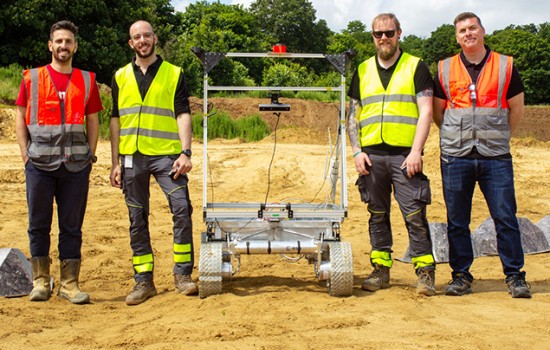GMV cements its leadership in the third phase of the biggest European Commission’s space robotics program
After featuring prominently in the program’s first and second phases, GMV will be acting as a strategic partner of the projects playing a key role in all third-phase projects of the H2020 Strategic Research Cluster (SRC) on space robotics technologies
In the three new robotics projects GMV will be taking on responsibility for the robotics components’ autonomy systems and cooperation capability, and will also contribute to the guidance, navigation and control systems (GNC)
The aim is to take one more stride towards a final demonstration of the orbital mission and set up a robotic collaboration demonstrator in a Mars-like terrain scenario

The European Commission (EC) has recently announced the three new third-phase projects of the Strategic Research Cluster (SRC) on space robotics technologies, coordinated by the PERASPERA project under the Horizon 2020 program (H2020).
The first phase of this ambitious, groundbreaking endeavor involved six projects (three led by GMV) to tackle the design, manufacture and testing in representative environments of various high-performance robotic Common Building Blocks suitable for operation in orbital or planetary space projects. The main objectives of the second call, now drawing to a close, are the integration of the previously prepared Common Building Blocks for space robotics resulting from the first phase into demonstrators on ground, targeting specific applications of space robotics in the field of orbital and planetary (Lunar-Martian terrains) use.
The remit of this third call, as far as on-orbit servicing missions are concerned, is, to take one more step towards a final demo in an orbital mission. Secondly, as far as planetary-exploration missions go, it aims to develop a robot-collaboration demonstrator in a Mars-like terrain.
GMV’s performance in the first two phases has won the company the ranking of a strategic partner in the three new projects resulting from the third call (CoRoB-X, EROSS+ and PERIOD), keeping its responsibility for critical systems like the robotics components’ onboard autonomy systems and cooperation capability, while also contributing towards the guidance, navigation and control (GNC) systems.
The Cooperative Robots for Extreme Environments project (CoRob-X), led by DFKI, will develop and demonstrate enabling technologies for multi-agent robotic teams, with the ultimate aim of improving inter-robot collaboration. The main application is the exploration of planetary surfaces, focusing on areas that are hard to reach like craters and lava tubes. CoRob-X will offer priceless insights for future robotic exploration missions in critical areas like locomotion, autonomy and inter-robot cooperation. A second use case, developed in the frame of this project, will reuse this technology for a ground mining scenario. GMV is a key partner in both use cases.
The two projects European Robotic Orbital Support Services + (EROSS+) and PERASPERA In-Orbit Demonstration (PERIOD) will design two mission concepts of respectively on-orbit servicing demonstration and in-orbit assembly with the aim to provide a European system to cater not only for service-providing satellites, but also the service-receiving satellites. All this will be based on the robotic technologies developed in the previous H2020 calls (1st and 2nd) of the space robotics SRC.
The demonstration mission concept of EROSS+, led by Thales Alenia Space, Joint Venture between Thales (67 %) and Leonardo (33 %), will take in the complete orbital rendezvous phase with a collaborative satellite prepared for on-orbit servicing. This includes the capture, service operations (refuelling, payload-replacement and -repair) plus in-orbit assembly. The idea is to vet the capability of carrying out in-orbit operations of this type for future missions.
PERIOD, led by Airbus Defence and Space GmbH, aims at a very ambitious demonstration scenario of an orbital factory concept. Under this project, a satellite will be built by the factory equipped with manipulators and tools and then inserted in an operational low-earth orbit (LEO). Manufacture includes the construction of an antenna, assembly of components and reconfiguration of the satellite in the factory itself. The demonstrator is housed on the ISS Bartolomeo platform, which will be upgraded to increase the capability-vetting level from structure manufacture and assembly right through to refuelling experiments.
GMV’s crucial role in these three projects confirms its European leadership in OBA (On-Board Autonomy) and GNC (Guidance, Navigation and Control) for orbital and surface applications.
“After more than 5 years of hard work we are very proud to reaffirm and reinforce our roles within this 3rd phase of the SRC on Space Robotics technologies. Our goal is now to collaborate with the main robotic institutions and companies and with the two big LSI enabling the use of robotic elements from former projects for enhancing and fostering commercialization of New Space and Industry 4.0. It is GMV’s aim to input its new-application expertise towards not only the future needs of exploration and exploitation of space but also potential spin-off and spill-over uses to other areas of robotic activity and applications on Earth, such as mining, nuclear, oil&gas, agricultural, automotive, or underwater applications” stated Mariella Graziano, Executive Director of Space Segment and Robotics in GMV.




